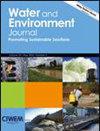微藻类是污水处理行业的多效益天然解决方案:英国试点规模研究
IF 1.8
4区 环境科学与生态学
Q4 ENVIRONMENTAL SCIENCES
引用次数: 0
摘要
用于废水处理(WWT)的微藻商业化受到限制,原因是标准系统占地面积大、水力停留时间(HRT)长,无法集成到废水处理(WW)灰色基础设施中。工业藻类学有限公司开发了一种工艺,可以操纵微藻的代谢可塑性,用于 WWT。在一个处理市政三级废水的 27 立方米示范工厂中进行的初步批量试验表明,在 12 小时 HRT 内,最终出水的磷酸盐和铵含量分别为 0.27 ± 0.2 毫克/升和 0.009 ± 0.003 毫克/升。在西南部水务公司拥有的一个小型农村污水处理厂中加装了一个连续通流系统,用于三级处理。在平均流量为 1.5-2.2 立方米/小时的情况下,对磷酸盐和新污染物(ECs)进行了为期 12 个月的监测。结果表明,微藻类工艺可作为绿色基础设施进行改造,为可持续发展带来重要效益。本文章由计算机程序翻译,如有差异,请以英文原文为准。
Microalgae as a multibenefit natural solution for the wastewater industry: A UK pilot‐scale study
Commercialization of microalgae for wastewater treatment (WWT) is limited due to the large footprints and long hydraulic retention times (HRT) of standard systems, making integration into wastewater (WW) grey infrastructure unfeasible. Industrial Phycology Ltd has developed a process that manipulates the metabolic plasticity of microalgae for WWT. Initial batch trials in a 27 m3 demonstration plant treating municipal tertiary WW achieved a final effluent of 0.27 ± 0.2 mg/L and 0.009 ± 0.003 mg/L phosphate and ammonium, respectively, in 12 h HRT. A continuous flow‐through system was retrofitted onto a small rural WWT site owned by South West Water for tertiary treatment. Phosphate and emerging contaminants (ECs) were monitored over 12 months at an average flow of 1.5–2.2 m3 /h. Consistent phosphate removal was observed with a reduction in ECs within a HRT of 16.5 h. This demonstrates that the microalgae process can retrofitted as a green infrastructure option, delivering benefits vital to sustainable development.
求助全文
通过发布文献求助,成功后即可免费获取论文全文。
去求助
来源期刊

Water and Environment Journal
环境科学-湖沼学
CiteScore
4.80
自引率
0.00%
发文量
67
审稿时长
18-36 weeks
期刊介绍:
Water and Environment Journal is an internationally recognised peer reviewed Journal for the dissemination of innovations and solutions focussed on enhancing water management best practice. Water and Environment Journal is available to over 12,000 institutions with a further 7,000 copies physically distributed to the Chartered Institution of Water and Environmental Management (CIWEM) membership, comprised of environment sector professionals based across the value chain (utilities, consultancy, technology suppliers, regulators, government and NGOs). As such, the journal provides a conduit between academics and practitioners. We therefore particularly encourage contributions focussed at the interface between academia and industry, which deliver industrially impactful applied research underpinned by scientific evidence. We are keen to attract papers on a broad range of subjects including:
-Water and wastewater treatment for agricultural, municipal and industrial applications
-Sludge treatment including processing, storage and management
-Water recycling
-Urban and stormwater management
-Integrated water management strategies
-Water infrastructure and distribution
-Climate change mitigation including management of impacts on agriculture, urban areas and infrastructure
 求助内容:
求助内容: 应助结果提醒方式:
应助结果提醒方式:


